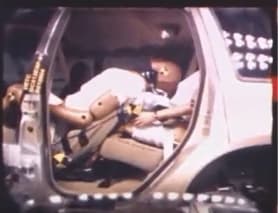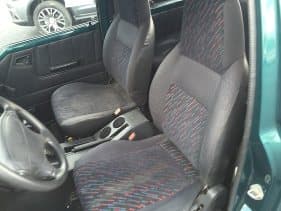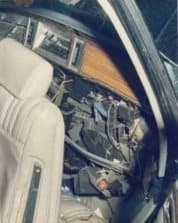Seatback Failure Lawyer
When it comes to seatback failures in a car accident, rollover or rear end collision, the dangers, and potential catastrophic injuries due to this seatback defect is inconceivable. Seat back failure defects exist in tens of millions of SUV’s automobiles, trucks and vans. Seatback failures are not limited to high-speed accidents, these seat backs can fail and collapse at low speeds too. It is well known by seat back failure experts and some automotive defect lawyers, that these seats back frames, hinges, anchors and brackets are defective and can bend, break, collapse and fail in rear-end impacts. When a seatback collapse occurs in an accident, it can often result in catastrophic injuries, paralysis, brain damage and even death. Federal vehicle safety standards are too low, automakers are too cheap, and occupants are too endangered by this defect.
At risk are  millions of Americans riding in vehicles with hidden seatback failure dangers — dangers which can lead to severe spinal cord injuries, traumatic damage injuries, head injuries, ejections and even death in rear-end collisions when defective seat backs can break or buckle, sending front-seat occupants into the rear of a vehicle and sometimes into the head and body of a rear seat passenger or child. In spite of hundreds of injured consumers filing a seatback failure lawsuit for their own injuries or losses, the automobile manufacturers have turned a blind eye to this growing problem when a seatback fails.
millions of Americans riding in vehicles with hidden seatback failure dangers — dangers which can lead to severe spinal cord injuries, traumatic damage injuries, head injuries, ejections and even death in rear-end collisions when defective seat backs can break or buckle, sending front-seat occupants into the rear of a vehicle and sometimes into the head and body of a rear seat passenger or child. In spite of hundreds of injured consumers filing a seatback failure lawsuit for their own injuries or losses, the automobile manufacturers have turned a blind eye to this growing problem when a seatback fails.
Front seat back failure can severely injure or kill a child in a car seat or even an adult. Minimum NHTSA seat back strength test and seat back testing should be mandatory and seat backs, frame and components strengthened 10-fold.
Seatback Failure Injury? – Talk to a Seatback Failure Attorney 1-800-883-9858
Children Injured in Seatback Failure Accidents
Though cars are becoming safer, the number of children dying in crashes has not declined but rather has risen. Such crashes are the number one killer of children aged 12 months or older, says federal agency the Centers for Disease Control and Prevention.
According to CBS News, since 1989 more than 100 persons — most of them children — have been severely injured or killed due to apparent seat-back failures. Many states, including Texas, legally require that young children be placed in safety seats in the rear of vehicles. In part, this is advised because exploding airbags in the front seats can injure or kill small, young passengers and in rollover accidents, the back seat occupants usually have lesser injuries.
Yet seatback failures to front seat passengers can make the back seat a dangerous place to be in a rear-end impact, especially when front seat occupants are hurled backward as the seatback failure occurs or seatback collapses into the formerly safe zone of the rear passengers. When a front seat or bucket seat failure occurs, children in these rear seats can suffer such serious injuries as chest trauma, skull fractures, brain damage, spinal cord injuries, blindness, paralysis, facial wounds, and broken legs. Parents should place children behind unoccupied front seats if possible or, if all front seats are occupied, behind the front seat whose occupant weighs the least. in fact, many seats still manufactured even as late as 2023 will fail in even moderate rear-end collisions, especially when the front seat occupant is a large individual. When such a seat back failure occurs the extra weighted front seat occupant will rear load the seat breaking or severely bending the hinge or frame causing rearward movement into the rear seat passenger causing severe injuries, head trauma, spinal cord injuries and even death. If this has happened to you or a family member, call an experienced seat back failure lawyer immediately, so the vehicle, the seats and seatbelts must remain intact and preserved as evidence in a products liability trial for the defective seat back.
Rear-End Impacts are Dangerous.
While most fatal accidents involve head-on car accident collisions, that doesn’t mean passengers in rear seats are safe, especially with defective seat backs rampant in American cars. In fact, these defective seat backs mean rear-end impacts can be terribly dangerous. In a rear-impact crash, a vehicle’s primary restraint system is its seat backs. Yet seats rarely remain upright in a rear-end crashes, so that even persons wearing seat belts and other restraints can be ejected from vehicles sometimes out the rear window.
Front-seat occupants can be injured or killed when hurled into the rear of the vehicle or into its roof in a rear-end impact after a seatback in the front of the vehicle breaks or collapses. Having rear passengers who sit behind them doubles the danger to occupants, since a front-seat occupant can slam into a back-seat occupant. Studies have shown such dangerous seat back failures can occur even when a vehicle is rear-ended by a car traveling only 16 miles per hour.
Remedies to Seatback Failures
European automakers Mercedes-Benz, BMW and Volvo have improved seatback efficiency beyond the low U.S. federal safety standards by strengthening seatbacks at a relatively low cost and decreasing serious injuries to front-seat passengers and often catastrophic injuries to rear passengers. Yet tens of millions of dangerous vehicles remain on our roads with ineffective seat-back designs.
How low are U.S. seat back safety standards? Some safety experts believe seat-back strength standards should be increased by at least 10 times the current level and various means of securing seats more strongly.
Among vehicles currently on our roads, seat back strength can vary widely. Also, being a four-door or two-door vehicle has no bearing on seat-back dangers. The strongest seats often are found on vehicles with shoulder belts attached to the seat rather than to the car frame.
Some automakers have argued that seat backs should collapse or give way to help protect front-seat occupants from whiplash in rear-end impacts. But the trade-off is having rear-seat occupants exposed to extreme dangers when collapsing seat backs and those seats’ occupants are hurled into the rear of the vehicle.
Recent Seatback Failures in the News
- Toyota Seat Back Failures
- Subaru Seat Back Failures
- Honda Seatback Failure
- Volvo Seatback Failure
- Acura Seatback Failure
- Ford Explorer Seatback Failure
- Hyundai Seatback Failure
- Mazda Seatback Failures
- Chevy -Chevrolet Seat Back Failures
Seatback Failure Lawsuits
Besides the numerous seatback failure lawsuits and seat frame, seat track and seating system and seat belt lawsuits of the Willis firm, other seatback defect lawsuits have been filed across the United States for over 30 years for adults and children severely injured or killed when the front seat occupant suddenly impacts the rear seat, a child, another adult, or part of the vehicle’s interior structure. In one seat failure lawsuit in San Antonio, Texas child was left with permanent paralysis, brain damage and loss of vision when his father’s seat back failed in a rear end collision allowing the father’s head and body to impact like a missile into his son seated directly behind him. The other occupant behind an empty or unoccupied front seat, was not hurt.
If your family has suffered a serious injury from a seatback failure accident, talk to an experienced seat back failure lawyer from the Willis Law Firm. We can fight for your legal rights and stand up to negligent automakers whose failure to spend just a few dollars more per vehicle could save children and adults across America from serious injuries and even death.
 Contact us today for your free case review. Talk to a seatback failure lawyer today with over 40 years of experience battling the automakers on auto defects for catastrophically injured clients. Call Toll Free 1-800-883-9858
Contact us today for your free case review. Talk to a seatback failure lawyer today with over 40 years of experience battling the automakers on auto defects for catastrophically injured clients. Call Toll Free 1-800-883-9858
Willis Client was rendered a paraplegic when her Geo Tracker’s seat back failed and she was launched rearward with her head and spinal cord impacting the rear seat and rear roof pillar. Our client was rendered a paraplegic from her injuries. A seatback failure lawsuit was filed against General Motors and the used car dealer that had incorrectly repaired the seat frame from a previous accident. The auto defect lawsuit was settled out of court.
Contact a Seat Back Failure Lawyer
If someone in your family was seriously injured or killed in an accident or a rollover in which you suspect a seatback failure, seat track defect or any automotive defect then call and talk to an experienced product defect lawyer from the Willis Law Firm to about your rights to file a seatback failure accident lawsuit. Let 40+years of experience in handling SUV and truck rollovers, auto defects, seat back failures, seat track defects, and tire failure cases on your side. We can help fight for your legal rights to claim for your family’s losses, including pain, suffering, lost salary, and medical and hospital bills due to your injuries due to a defective product.
Call Us Today at 1-800-883-9858 for a Free Seat Back Failure Lawsuit Review.
Causes of Seat Back Failure
The causes of seat back failure start with defective designs, followed by defective construction and installation of seat backs in vehicles. Such seat tracks can fail in a frontal collision or head-on-collision accidents can collapse or fail in several ways. Seat anchor hardware which fastens seats to the vehicle floor can pull out, or give way. Bolts which are supposed to hold seat tracks and slides in place can break or strip out. In some seat track failures, the seat adjuster and recliner locking teeth can shear off in head-on collisions. In a serious rear-end collision the seat frames can bend in half or fold over, and the seat back collapses and fails.
Unfortunately, federal safety standards are dangerously low for seat backs and seat tracks, due to the National Highway Traffic Safety Administration’s deaf ear for many years to heed the urgings of safety advocates, and seatback experts to improve seatback strength and efficiency.
NHTSA safety standards, namely the FMVSS 207 — written in the late 1960s — do not properly take into account the weight of occupants in vehicles’ front seats. Their weight can greatly contribute to breaking or buckling of seatbacks when front-seat occupants are hurled backward with great force in a rear-end collision. This can harm not only themselves but also the rear-seat occupants behind them, who can be injured or killed both by the front seat back collapsing along with the weight of front-seat occupants.
Call Us for a Free Seat Failure Lawsuit Review. Toll-Free 1-800-883-9858 or Click Here
Weak Seat-Back Safety Standards by NHTSA
Yet the NHTSA’s crash tests — conducted to study fuel tank dangers have shown that front seats often can collapse in rear-end collisions at just 30 miles per hour. Other seat failure studies show that even slower rear-end impacts can cause horrible seat-back failure injuries.
Investigations reveal that automakers have known of this design defect for decades. Yet few have gone beyond the perilously low federal standards for strengthening seat backs. What’s worse is that automakers are not required by the federal government to disclose their seat strength specifications, so many refuse to do so. The public, then, has little way of knowing if a vehicle’s seat back is especially dangerous. New car buyers are never told that it is safer to place a child behind an empty front seat, or at least behind the smallest or lightest of the seated front seat occupants. Seat back failure experts /seat design engineers will tell you of the dangers of placing anyone, whether be an infant in a baby seat (car seat), a child in a booster seat or even an adult behind a large, tall, or overweight person. Experts will all agree the bigger or heavier the person, the more likely that their particular seat back will collapse in a rear-end impact collision or during a rollover accident.
Even the NHTSA, while failing to take corrective action, has acknowledged that its seat strength standards set forth by Federal Motor Vehicle Safety Standard 207 in 1967 are “inadequate” to prevent seat-back collapse. In fact, it’s been shown that aluminum beach chairs, yard chairs or even seats made of cardboard can pass the current NHTSA’s “safety” standards for seat back strength.
Seat Track Failure Injuries in Frontal Collisions
The above picture was an actual case in which our client’s wife was killed when her Chrysler seat track failed to hold or lock slammed her headfirst into the dashboard and front roof pillar, causing traumatic brain injury and death. A wrongful death lawsuit was filed over this defective seat track frame design and inferior construction of the flimsy seat track and locking device. The seat track product defect lawsuit was settled out of court.
Seat tra cks can fail in a frontal collision or head-on-collision accidents when the manufacturer fails to add enough base metal to withstand the energies of a high-speed accident. When the accident occurs, the tracks, teeth, and latch can collapse in several ways. Seat anchor hardware which fastens seats to the vehicle floor can pull out or give way. Bolts which are supposed to hold seat tracks and slides in place can break or strip out. In some seat track failures, the seat adjuster and recliner locking teeth can shear off in head-on collisions.
cks can fail in a frontal collision or head-on-collision accidents when the manufacturer fails to add enough base metal to withstand the energies of a high-speed accident. When the accident occurs, the tracks, teeth, and latch can collapse in several ways. Seat anchor hardware which fastens seats to the vehicle floor can pull out or give way. Bolts which are supposed to hold seat tracks and slides in place can break or strip out. In some seat track failures, the seat adjuster and recliner locking teeth can shear off in head-on collisions.
Contact a Seatback Failure Lawyer
If your loved one was severely injured or died because of a seat back failure or seat collapse, seat track failure, seat hinge failure, or any other defective automotive product, then you may have the right to file lawsuit for your injuries and losses. Mr. Willis is a Board-Certified Personal Injury Trial Lawyer certified by the Texas Board of Legal Specialization and licensed in Texas and New York with a National Presence with the Highest Available Peer Review Rating of AV. Mr. Willis has practiced personal injury law, and products liability law for over 40 years. Let his extensive experience in product liability injury cases help you and your loved one get the justice you deserve.
